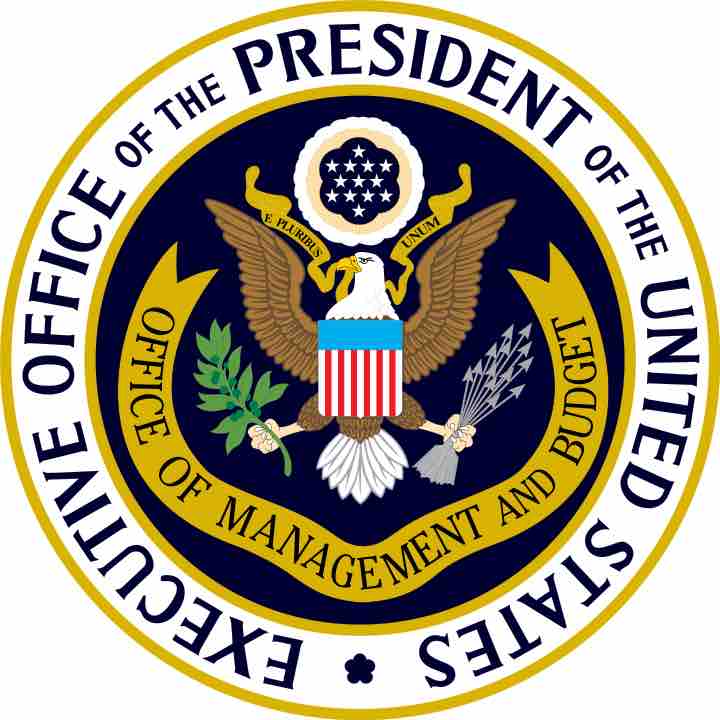The Cost of Maintaining the Government
Background
The Office of Management and Budget (OMB) is a cabinet-level office, the largest within the Executive Office of the President of the United States (EOP). The current OMB Acting Director is Jeffrey Zients.

U.S. Office of Management and Budget Seal
The Office of Management and Budget plays a key role in preparing the president's budget request to Congress.
The Budget and Accounting Act of 1921, which was signed into law by President Warren G. Harding, established The Bureau of the Budget, OMB's predecessor, as a part of the Department of the Treasury. As such, it was moved to the EOP in 1939, and then reorganized into OMB in 1970 during the Nixon administration.
The first OMB included Roy Ash (Head), Paul O'Neill (Assistant Director), Fred Malek (Deputy Director) and Frank Zarb (Associate Director) and two dozen others. In the 1990s, OMB was reorganized to remove the distinction between management and budgetary staff by combining those dual roles within the Resource Management Offices.
The OMB's predominant mission is to assist the President in overseeing the preparation of the federal budget and to supervise its administration in Executive Branch agencies. The OMB ensures that agency reports, rules, testimony and proposed legislation are consistent with the President's Budget and with Administration Policies.
In addition, the OMB oversees and coordinates the Administration's procurement, financial management, information and regulatory policies. In each of these areas, the OMB's role is to help improve administrative management; to develop better performance measures and coordinating mechanisms, and to reduce any unnecessary burdens on the public.
United States' Budget Process
Each year in March, the Congressional Budget Office (CBO) publishes an analysis of the President's budget proposals. (The CBO budget report and other publications can be found at the CBO's website. )
CBO computes a current law baseline budget projection that is intended to estimate what federal spending and revenues would be in the absence of new legislation for the current fiscal year and for the coming 10 fiscal years. However, the CBO also computes a current-policy baseline, which makes assumptions about, for instance, votes on tax cut sunset provisions. The current CBO 10 year budget baseline projection grows from $3.7 trillion in 2011 to $5.7 trillion in 2021.
The Houseand Senate Budget Committees begin consideration of the President's budget proposals in February and March. Other committees with budgetary responsibilities submit requests and estimates to the Budget committees during this time. The Budget committees each submit a budget resolution by April 1. The House and Senate each consider those budget resolutions and are expected to pass them, possibly with amendments, by April 15. Budget resolutions specify funding levels for appropriations committees and subcommittees.
Appropriations Committees, starting with allocations in the budget resolution, put together appropriations bills, which may be considered in the House after May 15. Once appropriations committees pass their bills, the House and Senate consider them. A conference committee is typically required to resolve differences between House and Senate bills. Once a conference bill has passed both chambers of Congress, it is sent to the President, who may sign the bill or veto. If he signs, the bill becomes law. Otherwise, Congress must pass another bill to avoid a shutdown of at least part of the federal government.
In recent years, Congress has not passed all of the appropriations bills before the start of the fiscal year. Congress has then enacted continuing resolutions that provide for the temporary funding of government operations.
Budget Resolution
The next step is the drafting of a budget resolution. The United States House Committee on the Budget and the United States Senate Committee on the Budget are responsible for drafting budget resolutions. Following the traditional calendar, by early April both committees finalize their drafts and submit it to their respective floors for consideration and adoption.
A budget resolution, which is one form of a concurrent resolution, binds Congress, but is not a law, and so does not require the President's signature. The budget resolution serves as a blueprint for the actual appropriation process and provides Congress with some control over the appropriations process.
In general, an Authorizing Committee, through enactment of legislation, must authorize funds for Federal Government programs. Then, through subsequent acts by Congress, the Appropriations Committee of the House then appropriates budget authority. In principle, committees with jurisdiction to authorize programs make policy decisions, while the Appropriations Committees decide on funding levels, limited to a program's authorized funding level, though the amount may be any amount less than the limit.
In practice, the separation between policy-making and funding, and the division between appropriations and authorization activities are imperfect. Authorizations for many programs have long lapsed, yet still receive appropriated amounts. Other programs that are authorized receive no funds at all. In addition, policy language, that is, legislative text changing permanent law, is included in appropriation measures.